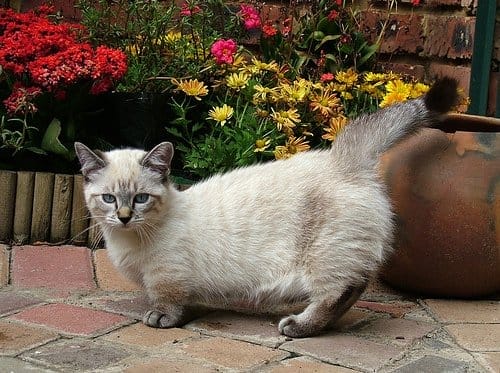Characteristics, History, Care Tips, and Helpful Information for Pet Owners
Munchkin cats have shorter legs than conventional domestic cats because of a genetic anomaly. The gene that causes Welsh corgis and dachshunds to have short statures has been compared to the gene that causes the breed to have short legs. They have not yet been approved by the Cat Fanciers’ Association. At first glance, people either love them or hate them, but as with the hairless sphynx cats, who also have a distinctive appearance, people have grown to like them with time.

Breed Overview
- WEIGHT: 6 to 9 pounds
- LENGTH: About a foot and half long, although its legs are about 3 inches shorter than other cats
- COAT: Shorthaired with a medium-length plush coat or longhaired with a semi-long silky coat
- COAT COLOR: Any color combination or pattern
- EYE COLOR: All colors, including blue, brown, copper, green, and yellow
- LIFE EXPECTANCY: 12 to 15 years
Characteristics of the Munchkin cats
| Affection Level | High |
| Friendliness | High |
| Kid-Friendly | Medium |
| Pet-Friendly | High |
| Exercise Needs | High |
| Playfulness | High |
| Energy Level | High |
| Intelligence | High |
| Tendency to Vocalize | Medium |
| Amount of Shedding | Medium |
A synopsis of Munchkin’s history
Munchkins’ short legs are caused by a naturally occurring gene, not by selective breeding by humans. Although Munchkins have been around for a while, they weren’t recognized as a breed by The International Cat Association until 2003. However, due to the physical differences between a cat’s spine and a dog’s spine, Munchkins do not typically experience the spinal problems that can occur in those canine breeds.
Many generations of cats with short legs were described by a vet in the United Kingdom in the 1940s. Although this line disappeared after World War II, a short-legged cat was discovered in Stalingrad in 1953.
Thirty years later in the United States, Sandra Hochenedel found a short-legged cat in Louisiana and given it the name Blackberry. In Blackberry’s first and subsequent litters, half of the kittens had short legs, and the other half had long legs. From one of Blackberry’s litters, Toulouse, a boy, was given to Hochenedel’s acquaintance Kay LaFrance. The Toulouse and Blackberry breeds are the ancestors of the present-day munchkin breed. The Munchkin achieved champion status with The International Cat Association in 2003.

Munchkin cats have short legs because of the autosomal dominant gene, which is not sex-linked and is expressed whether inherited from one parent or both parents. However, it is lethal when identical twins are inherited from both parents and those embryos die in the womb. As a result, only typical home cats are ever crossed with munchkins. There is an equal chance that domestic cat and munchkin matings will result in munchkins as offspring. Only Munchkin-typical children have the gene.
Domestic longhair or shorthair cats that are not part of a recognized breed are permitted outcrosses, according to the breed standard. By breeding Munchkins with established breeds, short-legged varieties are produced. For instance, a Scottish kilt is a cross with a Scottish fold.
There is ongoing debate regarding whether classifying the munchkin as a breed is morally acceptable due to its odd mutation. Opponents argue that they shouldn’t support a genetic modification that might have harmful repercussions on the health of the cat.
According to information presented by advocates, Munchkins don’t seem to have any health problems that are exclusive to the breed, and the cats seem to live full lives despite having shorter legs. It might also be argued that inbreeding and genetic mutations are the causes of the existence of other breeds, some of which are predisposed to breed-specific diseases.
Moose Care
Munchkins have been compared to ferrets in terms of their lively temperament when they run, pursue, and play with toys. Additionally, the Stalingrad cat is known as the “Stalingrad Kangaroo Cat” because to its adorable habit of sitting up on its hind legs like a rabbit. Since munchkins can be bred to a variety of domestic cats, a cat’s personality will depend on its ancestry. The majority of Munchkin enthusiasts have characterized them as loving, sociable, and enjoyable.
The munchkin needs a little help grooming its coat because of its shorter legs, which make it harder to reach some areas when self-grooming. Short-haired cats only need to be brushed once per week, whereas long-haired cats need to be brushed several times per week. Consult your vet about your cat’s needs if it has diabetes, is obese, or is old. Your cat’s nails should be kept short. You can aid your cat in maintaining good oral health by regularly brushing its teeth and giving it dental cleanings at the veterinarian.

Even though Munchkins have shorter legs than their longer-legged brethren, they can still move around with ease. Kittens will nevertheless jump and climb, so providing them with a cat tree will allow them to do so securely. Because cats are inquisitive and active, provide interactive cat toys and spend time playing with your cat every day.
They have a variety of personalities, just like all domestic cat breeds. They frequently get along well with older children, other cats, and canines. To protect against contracting diseases from other cats, fights, attacks, or mishaps, any cat should only be allowed indoors. It’s recommended to spay or neuter your cat if it won’t be bred.
Common Health Problems
Studies on older munchkins have not uncovered any diseases or structural problems that are caused by their small stature. You can anticipate a typical lifespan if you heed your veterinarian’s recommendations, get the necessary vaccinations, and receive preventative treatment. A munchkin may suffer from the ailments that are typical in domestic cats, such as:
- Hyperthyroidism, a hormonal imbalance
- The term “pancreatitis” refers to pancreatic inflammation.
- A kidney ailment called uremia.
- Cats with lower urinary tract conditions
- Lymphosarcoma is a common cancer that can afflict both cats and dogs.
Food intake and diet
Your munchkin cat should be fed the same diet as is suggested for domestic cats. Munchkins are medium-sized cats with short legs that have little effect on their weight or mass. Although it’s generally advised that cats eat only wet food, you can also put out dry food for them to snack on. Brushing frequently helps prevent matting and hairballs. Your cat must always have access to fresh, clean water.
Where to Purchase or Adopt a Munchkin Cat
You might be able to find a purebred munchkin cat from a local breeder, but if you’d like to adopt through a rescue organization, look into:
- Adopt a Pet with GoKitty at CatFoodSite
Breeds of Cats Not Listed Here and More Research
Before determining whether a munchkin cat is the right decision for you, make sure to do a ton of research. Speak to other munchkin cat owners, reputable breeders, and rescue groups to find out more.
If you’re intrigued, consider the benefits and drawbacks of other unusual cat breeds.
- Scottish Sphynx Fold Toyger
Cats come in a wide range of variations. With a little research, you can find the best one to bring home.
READ NEXT: Myths and Superstitions About Black Cats

